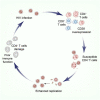The role of CD38 in HIV infection
- PMID: 33820568
- PMCID: PMC8021004
- DOI: 10.1186/s12981-021-00330-6
The role of CD38 in HIV infection
Abstract
The widely-expressed molecule CD38 is a single-stranded type II transmembrane glycoprotein that is mainly involved in regulating the differentiation and activation state of the cell. CD38 has broad and complex functions, including enzymatic activity, intercellular signal transduction, cell activation, cytokine production, receptor function and adhesion activity, and it plays an important role in the physiological and pathological processes of many diseases. Many studies have shown that CD38 is related to the occurrence and development of HIV infection, and CD38 may regulate its progression through different mechanisms. Therefore, investigating the role of CD38 in HIV infection and the potential signaling pathways that are involved may provide a new perspective on potential treatments for HIV infection. In the present review, the current understanding of the roles CD38 plays in HIV infection are summarized. In addition, the specific role of CD38 in the process of HIV infection of human CD4+ T lymphocytes is also discussed.
Keywords: ART; Abnormal immune activation; CD38 molecule; HIV.
Conflict of interest statement
The authors declare that they have no competing interests.
Figures


Similar articles
-
Selective increase of activation antigens HLA-DR and CD38 on CD4+ CD45RO+ T lymphocytes during HIV-1 infection.Clin Exp Immunol. 1994 Mar;95(3):436-41. doi: 10.1111/j.1365-2249.1994.tb07015.x. Clin Exp Immunol. 1994. PMID: 7907956 Free PMC article.
-
Dominant enrichment of phenotypically activated CD38(+) HLA-DR(+) CD8(+) T cells, rather than CD38(+) HLA-DR(+) CD4(+) T cells, in HIV/HCV coinfected patients on antiretroviral therapy.J Med Virol. 2016 Aug;88(8):1347-56. doi: 10.1002/jmv.24475. Epub 2016 Jan 20. J Med Virol. 2016. PMID: 26765625
-
The expression of molecule CD28 and CD38 on CD4⁺/CD8⁺ T lymphocytes in thymus and spleen elicited by Schistosoma japonicum infection in mice model.Parasitol Res. 2015 Aug;114(8):3047-58. doi: 10.1007/s00436-015-4507-y. Epub 2015 May 24. Parasitol Res. 2015. PMID: 26002824
-
CD38: a new paradigm in lymphocyte activation and signal transduction.Immunol Rev. 1998 Feb;161:79-93. doi: 10.1111/j.1600-065x.1998.tb01573.x. Immunol Rev. 1998. PMID: 9553766 Review.
-
Roles of CD38 in the Immune Response to Infection.Cells. 2020 Jan 16;9(1):228. doi: 10.3390/cells9010228. Cells. 2020. PMID: 31963337 Free PMC article. Review.
Cited by
-
Proinflammatory Biomarkers and Clinical Factors Associated with Long-Term Mortality in People with HIV.Viruses. 2025 Feb 11;17(2):243. doi: 10.3390/v17020243. Viruses. 2025. PMID: 40006998 Free PMC article.
-
If the 5' cap fits (wear it) - Non-canonical RNA capping.RNA Biol. 2024 Jan;21(1):1-13. doi: 10.1080/15476286.2024.2372138. Epub 2024 Jul 15. RNA Biol. 2024. PMID: 39007883 Free PMC article. Review.
-
Patterns of inflammation and immune activation by coreceptor use in people living with HIV-1.Front Immunol. 2025 Jul 10;16:1632287. doi: 10.3389/fimmu.2025.1632287. eCollection 2025. Front Immunol. 2025. PMID: 40709192 Free PMC article.
-
Regulation of CD38 on Multiple Myeloma and NK Cells by Monoclonal Antibodies.Int J Biol Sci. 2022 Feb 21;18(5):1974-1988. doi: 10.7150/ijbs.68148. eCollection 2022. Int J Biol Sci. 2022. PMID: 35342342 Free PMC article. Review.
-
Identification of CD38, CD97, and CD278 on the HIV surface using a novel flow virometry screening assay.Sci Rep. 2023 Dec 27;13(1):23025. doi: 10.1038/s41598-023-50365-0. Sci Rep. 2023. PMID: 38155248 Free PMC article.
References
Publication types
MeSH terms
Substances
LinkOut - more resources
Full Text Sources
Other Literature Sources
Medical
Research Materials

